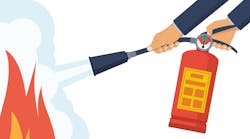Having the right crisis management team in place can mean the difference between survival and going out of business following a disaster.
Speaking at a recent NationaLease meeting, Geary Sikich, principal, Logical Management Systems Corp., said that the biggest challenge to building an effective crisis management team is getting team members to work together when they generally do not function every day as a team. And, according to Sikich, the next biggest challenge is “getting the team to comprehend their crisis management roles, responsibilities, functions and how they differ from their day-to-day roles, responsibilities and functions.”
There are several reasons why crisis management teams fail, including not being aware of reaction time, poor communication, micro-managing, decisions are left at low levels and allowing problems to compound.
To build an effective crisis management team you need a combination of people, tools and structure aligned with the following:
- A common mindset among team members
- Training
- Recognition of weaknesses, hazards, opportunities, threats, strengths, underlying plans
- Active analysis including situational awareness and communication
- Focused efforts that build credibility
- Flexible structure that supports long-term functional needs
In his presentation, Sikich referred to Gary Klein’s “Sources of Power: How People Make Decisions.” Klein identified the following things to consider when evaluating a crisis management team.
- Team competencies: How good are the team members? Are they struggling with basic procedures?
- Team identity: Does everyone on the team know who does what? Do team members help each other? Is anyone micro-managing? Is anyone “out of it?”
- Team cognition: Is the team heading for the same goals? Does everyone have the same picture? Are they consistently in a reactive mode? Do they get paralyzed by uncertainty?
- Team metacognition: Who’s taking responsibility? Do they spot and correct problems? Do they get crunched for time? Are they territorial?
A team that is comprised of the right people from across the organization can lead an organization during and after a disaster so that it gets back to normal operations as quickly as possible.



